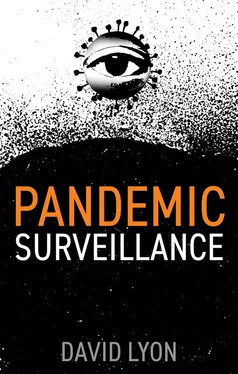As well as the massively increased use of highly data-hungry platform companies that we use to keep in touch with those from whom we were suddenly separated, there were other modes of surveillance for monitoring employment, schooling and shopping at home. US companies Amazon and Walmart increased their profits by 56 percent in 2020, to total $10.7 billion. So far from the familiar notion that the home is a haven from prying eyes, providing a secure threshold from unwanted outside agencies, it became even more of a data-rich target.
Chapter 4, “Data Sees All?,” dives into the world of data to discover why this abstract-sounding entity is so valued today. The pandemic hit in an era when data has become central to almost every facet of contemporary life. We explore how data is universally used as a “way of seeing” – while reminding ourselves that it is also a way of not-seeing. In this context, data is used to make our lives visible to others. Understandably, epidemiologists wish to know who has been with whom, where and for how long, and the data they collect and analyze allows them to “see” the lives of those in each community. But what might be missing from this?
Though many surveillors – especially platform companies – are not very transparent about what exactly they are doing, they make our lives very transparent to them. It is impossible for ordinary citizens to keep up with what data is being collected on them, especially now, with so many other pandemic preoccupations to deal with. It is not just a question of “collecting” data either. How that data is analyzed, using algorithms, is also crucial for outcomes. And those outcomes include being treated in a particular way, following the analysis. In China, if your color-coded situation obliges you to stay home, facial recognition camera surveillance or drones buzzing outside your apartment window make you even more visible to public health authorities.
These kinds of issues definitely raise questions about privacy, and they have to be faced squarely. But there are other sorts of questions here, that have to do with how populations are sorted into different categories – for example, for knowing which age-groups or work-positions should be vaccinated first. In Chapter 5, “Disadvantage and the Triage,” these questions are investigated. When you go to an emergency department, you have to go through a “triage” process. The nurse on duty must sort out, on the basis of available information, which patients are in most urgent need of attention and care. Surveillance works like this – it sorts between different categories in the population so that different groups can be treated differently. 27
COVID-19 has not only exposed how some populations are more vulnerable than others, and that there are inequalities of access to testing and vaccines. Pandemic surveillance also leads to variable treatment such that some experience very negative discrimination. Inequalities that have become very apparent – the disadvantages faced by people in poverty, migrant workers, visible minority groups – are sometimes also made even worse by pandemic surveillance. Questions of civil liberties and other rights are raised, nationally and globally.
Such issues prompt questions about power and how it is distributed. Chapter 6, “Democracy and Power,” explores an upsurge of pandemic-prompted state surveillance, of which issuing “vaccine passports” is a good example. But we also have to face the fact that “state surveillance,” which has for so long been the main worry for privacy advocates, is not the only kind evident in the COVID-19 global pandemic. Today’s surveillance reveals itself in public–private partnerships – as is clear from the “contact tracing” apps that are nearly all products of both government and corporation, whether Huawei in China or IBM in the United States.
Of course, state and market can still be distinguished, but increasingly they are intertwined – including in their surveillance activities. The platform companies have ramped up their data-gathering during the pandemic. Many of these developments occurred in understandable haste, sometimes without adequate preparation – for public health initiatives, monitoring and checking on citizen compliance, and for stimulating demand for commercial pandemic services. Not only that, many are concerned that the seemingly temporary measures of intensified surveillance – sometimes enabled by changed regulations or laws – will become permanent features of society.
In the concluding chapter, “Doorway to Hope,” threads are pulled together. The negative aspects of pandemic surveillance are not inevitable or inescapable. In a future pandemic, things could be done differently – and, indeed, lessons from COVID-19 could also be learned for a post-pandemic world. A major issue is the use of data within surveillance devices, apps and systems. “Tech-solutionism” is a palpable problem – there’s more than one way to achieve results.
This book points to a different way, to start with people and public health, and not with technology. And if aspects of pandemic surveillance are unfair, then a different approach is to begin by aiming for “data justice.” This is the quest for fairness in the ways in which people are made visible, represented and treated – and it’s one of those things that makes possible human flourishing and the common good. This approach goes beyond privacy and also makes seeking alternatives everyone’s business. Indeed, it strikes a note of hope, a doorway through which all may walk.
1 1 See Amy L. Fairchild, Ronald Bayer and James Colgrove, Searching Eyes: Privacy, the State and Disease Surveillance in America (Berkeley: University of California Press, 2007); and https://daily.jstor.org/john-snow-and-the-birth-of-epidemiology. See also Lorna Weir and Eric Mykhalovskiy, Global Health Vigilance: Creating a World on Alert (London: Routledge, 2010).
2 2 David M. Morens, Gregory K. Folkers and Anthony S. Fauci, “What is a pandemic?” The Journal of Infectious Diseases, 200 (7) 2009: 1018–21.
3 3 www.who.int/immunization/monitoring_surveillance/burden/vpd/en.
4 4 Robert Fahey and Airo Hino, “COVID-19, digital privacy and the social limits on data-focussed public health responses,” International Journal of Information Management, 55 (December) 2020: www.ncbi.nlm.nih.gov/pmc/articles/PMC7328565.
5 5 Eun-Young Jeong, “South Korea tracks virus patients’ travels – and publishes them online,” The Wall Street Journal, February 16, 2020.
6 6 Surveillance capitalism was first described by John Bellamy Foster and Robert W. McChesney in “Surveillance capitalism: Monopoly finance capital, the military-industrial complex and the digital age,” Monthly Review, 66 (3) 2014: https://monthlyreview.org/2014/07/01/surveillance-capitalism; and Vincent Mosco, To the Cloud: Big Data in a Turbulent World (Boulder: Paradigm, 2014); but its best-known analyst is Shoshana Zuboff in The Age of Surveillance Capitalism (New York: Public Affairs, 2019).
7 7 www.vice.com/en/article/bv8ga4/sidewalk-labs-abandons-its-smart-city-in-toronto.
8 8 Sidney Fussell, “The city of the future is a data-collection machine,” The Atlantic, November 21, 2018: www.theatlantic.com/technology/archive/2018/11/google-sidewalk-labs/575551.
9 9 Julia Powles, “Why are we giving away our most sensitive health data to Google?” The Guardian, July 5, 2017.
10 10 Albert Camus, The Plague (English trans. of La Peste) (Harmondsworth: Penguin, 1960).
11 11 Laura Spinney, Pale Rider: The Spanish Flu of 1918 and How it Changed the World (London: Cape, 2017).
12 12 Nurhak Polat, “Dijital pandemi gözetimi, beden politikalari ve esitsizlikler” (“Digital pandemic surveillance, body politics and inequalities”), Feminist Approaches in Culture and Politics, 41 (Autumn) 2020. The English translation of the quotation is courtesy of the author.
Читать дальше












